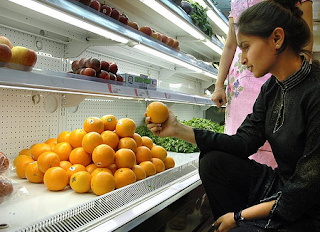
Soybean, the miracle crop of India introduced very recently, had helped in stemming the foreign flow of exchequer, as well as become the lifeline of rainfed and other neglected tracts of the country. It outperformed other high value crops too, under intensive production with assured irrigation, nutrition and protection.
Soybean originally belonging to Manchurian region of China, is not a new crop to India. It was grown in India long before it was introduced to the USA in the early 1800s. Black soybean has been grown for ages in low Himalayan hills as well as in the foothills and some scattered pockets of central India.
India's unusually rapid development of soybean is highly area-specific i.e., Madhya Pradesh experienced a 38 fold increase in area during 80’s and a similar increase in production. Uttarakhand (erstwhile Uttar Pradesh’s Tarai belt) increased its area and production 8-10 times while Maharashtra's soybean crop had become insignificant by 1983. Major factor responsible for concentrated soybean development seems to be the development of irrigation systems to compensate for unfavourable climatic factors along with promotion of soybean as an intercrop with sorghum and cotton, and the assured market in these areas. Even though India's share is about one percent at present, development as well as the expansion of this crop in the country during the last 15 years is rated as one of the striking occurrences in the agricultural development process, which made India, 5th largest producer of Soybean.
Soy- Vantage
Soybean is a multi-purpose crop, as it is used for food, feed and fodder. Its short crop duration and fast growth habit makes it highly suitable as intercrop or, catch crop as it suppresses weeds. Except yellow mosaic and rust disease, it is tolerant to other disease problems and almost no/low pest incidence. The nutrients application is also too minimal, being an efficient nitrogen fixing leguminous crop. It does not require much water and other cultural activities/ management, so a big hit in the rainfed and dryland areas. The leaves are shelf shed, so no need for separating the pods and leaves, which decompose and add organic matter to the soil. Soybean has great nutritional significance, with over 40% protein and 20% oil, and has now been recognized as a potential supplementary source of edible oil and nutritious food. The protein of soybean is complete, because it supplies sufficient amounts of the kinds of amino acids required by the body for building and repair of tissues. Its food value in heart disease and diabetes is well known. Soybean is a rich source of edible oil containing no cholesterol and almost none of the saturated fats. Thus it constitute an ideal food for heart patients and those who wish to avoid heart disease. After all it’s an economic crop to go for, but with assured market and local preferences.
Madhya Pradesh- the Soy State
Soybean is grown in Madhya Pradesh during kharif and has spearheaded their economic growth. Various processed products like Soy milk, Soya meal, Nutri Nugget, Oil, cattle and poultry feed are available even in the rural areas. The research and educational back up is from AICRP- Soybean, now elevated as National Research Centre and JNKV, Jabalpur. As on today, about 70% of Soybean is produced by MP alone. Soybean farmer Mohan Singh of Ratlam, M.P. says, “Today, soybean marketing is not a problem, only our comprehension is for the right prices, which is highly fluctuating due to imbalanced international trade. Soybean, having less production problems, requiring less management and considerably lower cost of cultivation, make us the farmers in the region to go for the crop”. The major constraints in production include non-availability of adequate amount of quality seed, poor adoption of improved production technology and the risks of crop cultivation in rainfed conditions. Soybean seed is least storable and is vulnerable to mechanical damage. Use of quality seed with high germination is, hence, imperative.
The Roadblocks:
Despite its nutritional importance, Soybean has not been able to catch up in the domestic market and lure the Indian growers except few places in MP, Uttarakhand, Rajasthan and Northern Karnataka, much due to severe neglect from the Government side. The major constraint to sustained development of soybean remains the low and declining yields. Consumer and farmer education and governmental support can help increase yields; increased industrial utilization of the crop can become more important. Narendra Kumar, an Agriculture Officer with Agriculture Dept. says, “Soybean is not getting the boost, due to faulty Govt. policies and imbalanced trade. India having more than 60% of area under rainfed and dryland can encash the opportunity by going with the crop, where nothing grows with the least inputs and cultural practices”. High yields are constrained by a complex interaction of genetic, physiologic and climatic factors. It can be proved as a panacea for perennial malnutrition problems that India and other developing nations are confronting at present. Available varieties are low yielding, thus urgently needed are high-yielding varieties to bridge the existing yield gap. Most of the Indian households tried to use soybean as dhal and failed, because it required much more time to cook and yet did not cook up well, like the other dhals. Also, some people did not like its beany flavor. As a result, soybean did not gain wide popularity in India. So, utilization has to be made familiar to suit the local tastebuds, which would automatically create the huge market for the crop.
International Trade
Soybean is a versatile food product and is mostly imported. The major players in international arena are US, Brazil, Argentina and China. The USA, Brazil and Argentina account for a combined 82% of global output; they are followed, at considerable distance, by China, India and Paraguay, which, together, account for another 13% of world production. China is the largest importer with import of over 45% of world soybean. Agronomic advances have led to dramatic growth in the supply and utilization of soybeans worldwide. Today, the share of soybean in global oilseed production averages around 55 %, and over the last ten years world soybean production has expanded at a rate of over 5 % per year on average. In the world’s three largest producing countries, the USA, Brazil and Argentina, about 70-90 % of soybean produced consists of GM varieties. On the consumption side, the advent of GM soybeans and other food crops has created considerable debate following consumer concerns about the safety of GM products. In India also, HT- Soybean release controversy is catching up, as the MNCs is in the race to cash in on the early gains. Dr. Bijendra Singh, a trade analyst admitted “As currently the international market is sluggish, but with the late and poor monsoon this season, the crop can vie for getting the attention with the higher prices.”
The Ways ahead:
The prospects of soybean expanding further into a major crop in India are good. The know-how accumulated on soybean farming in India is already considerable, and industry is becoming increasingly aware of the varied uses of soybean. It appears that the importance of soybean is increasing while the availability of pulses, the nation's cheapest source of protein, is decreasing. Marketing is still a major roadblock in its large scale expansion with the low share in local domestic market, irrespective of innumerable nutritional and economic gains. The first thing is the creation of domestic demand and market among the local consumer/ people, which can replace our whole dependency on the international trade, which is highly skewed. The consumers and public has to be educated, taught and the benefits of Soybean must be vehemently promoted. With the marketing problem out of the way, the next challenge is to develop improved, high yielding soybean varieties with good seed viability and resistance to yellow mosaic and rust. Furthermore, the soybean seeds of these varieties stored under ambient conditions quickly lose viability; when planted in the next season, their germination was found to be very poor. Therefore, breeding for resistance to yellow mosaic and rust as well as for increased seed longevity is the major challenge among soybean breeders in India. Seed viability during storage was observed to be related to seed size, .i.e. varieties with a 100, seed weight of more than 15 g lost viability quickly, whereas varieties with a 100-seed mass of 10 g or less showed little loss of viability even after a year. However, these small-seeded varieties had low yield and low oil content. On the other hand, varieties with a 100-seed mass of 12–15 g maintained good viability for 7–8 months, had good yield potential, and contained high levels of oil and protein. Therefore, seed mass became one of the selection criteria in the breeding program for improved seed viability.
The rapid increase of soybean cultivation raises a good possibility of meeting the edible oil shortage in India. The political will and financial support from the State and central governments were matched by the private-sector investment in soybean utilization and marketing in India. This brought about a rapid increase of soybean cultivation in all the potential niches, but as expected, the major expansion took place in Madhya Pradesh, which alone accounts for 81% of the area under soybean today. Consequently, India is currently cultivating about 6 million ha with an annual production of 6 million t, and it proudly occupies the 5th place in the world for soybean production. At last it can save huge losses, we incur on importing pulses and edible oils from Canada and Australia. So, an urgent policy intervention is needed to keep the magic run of Soybean.
Abid Hussain




